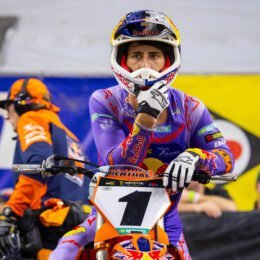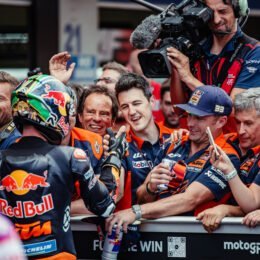#inthisyear2007: KTM factory rider Cyril Despres wins the last Dakar Rally in Africa
KTM had been unbeaten since 2001 when more than 140 riders lined up for the start of the 39th edition of the Dakar Rally in Asunción on January 2, 2017. Orange was once again the predominant color at the start line – over half of the competitors had opted for the machine that so often wins this event, the KTM 450 RALLY.
The race started in Paraguay for the first time, and Paraguay thus became the 29th country to host one or more stages of the event in its almost 40-year history. This year the route passed through Paraguay, Bolivia and Argentina. Generally regarded as the hardest rally in the world, the Dakar was first held in 1978, starting from Paris on December 26. In its early years, the route led from the Trocadero in Paris to Lac Rose in Dakar, the capital of Senegal. After the 2008 Dakar Rally was called off just one day before it was due to start because of a terror warning, the race has since been held every year in South America. It has nonetheless retained its name: Dakar. Let’s take a look back at the last Dakar Rally to be contested on African soil, which got underway exactly 10 years ago in Portugal.
It had taken KTM five years to finally make their breakthrough in 2001. Ever since then, no other manufacturer has been able to claim the distinction of their machine being the first to cross the finish line at Lac Rose.
After their resounding success in the 2006 edition – which was won by Marc Coma and in which KTM riders also claimed every finishing position from second to seventh – the KTM motorsport division soon started preparing for Dakar 2007. The Dakar was seen as the ultimate test for the recently developed KTM 690 RALLY. The aim was to be able to present the 690 RALLY REPLICA to the multitudes of non-professional riders in the following season as a motorcycle with race-proven, winning engineering. Its single-cylinder engine had been completely redeveloped and installed in an extremely resilient tubular trellis frame. As a result, the engineers had managed to reduce the bike’s weight from the previous year’s model by several kilos.

KTM 660 RALLY 2007
With eight riders in the three KTM factory teams sponsored by Gauloises, Repsol and Red Bull, KTM was broadcasting loud and clear its intention of defending its title. The previous year’s winner, Marc Coma (Repsol KTM), and Cyril Despres (Gauloises KTM) – two of the best riders in the world – were amongst the red-hot favorites for this classic race. In all the team comprised 43 people, including one doctor and two physiotherapists. As well as servicing the three factory teams, KTM was also supporting the army of individual KTM riders that made up the majority of the motorcycle competitors. Over 35 tons of material were brought along on two race trucks and four service trucks, the latter being set up as rolling workshops ready to provide any form of assistance. Needless to say, KTM was focused not only on sporting success, but also on the safety of every single rider. For the first time ever, all the KTM factory riders wore a new design of neck brace.
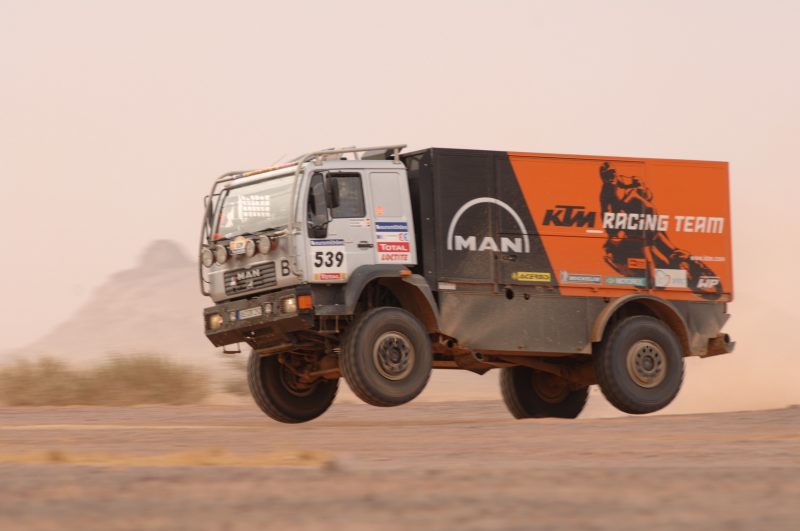
KTM Service Truck
The race started on January 6 in Lisbon, and at first the KTM riders took things nice and steady, at least for as long as the race and attendant caravan was still on European soil. This changed, however, as soon as the first special stages were about to be held on the African continent. The previous year’s winner, Marc Coma, immediately threw down the gauntlet by winning the first two stages in Morocco. Cyril Despres, the 2005 winner, had remained within striking distance of the lead, and his performances were getting better and better after the rally crossed Mauritania. On the 12th stage from Mauritania to Mali, Coma made a navigation error and then crashed, as a result of which he had to retire from the race. Despres eventually secured his second Dakar victory with a 34-minute lead over his Gauloises KTM teammate David Casteu. Third place on the podium was claimed by Chris Blais of Red Bull KTM.
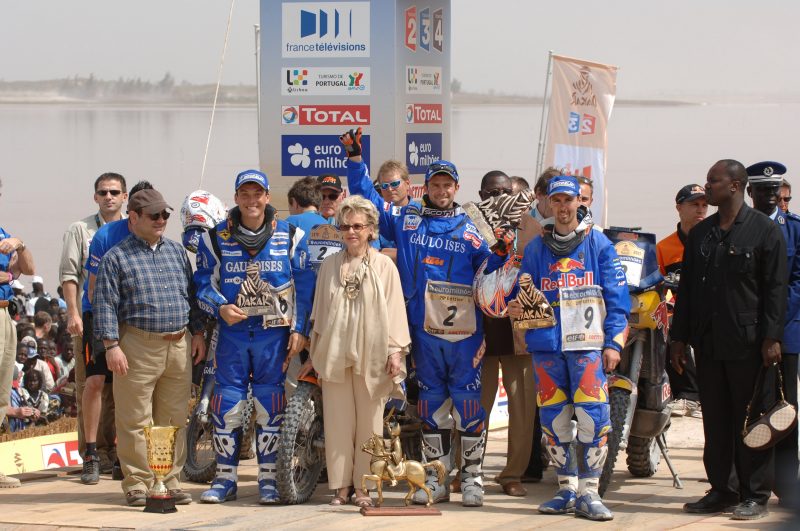
David Casteu (FRA), Cyril Despres (FRA) & Chris Blais (USA) Dakar 2007
From 2009 onwards, after the Dakar was relocated to South America, Despres and Coma continued to be the riders to beat. Even a last-minute regulations change imposed by the rally organizer failed to alter this, with Despres and Coma still securing victory on the KTM 450 RALLY, with its smaller engine. Following his fifth victory in the Dakar Rally in 2013, Despres switched over to cars. After his fifth victory in 2015, Marc Coma also called time on his riding career and moved into an organizational role as the Rally’s Sporting Director. So the deck of cards was reshuffled from 2016 once Despres and Coma, the two dominant riders throughout the previous decade, were no longer competing. For KTM this entailed a new start with young riders hungry for success; and two highly promising competitors were found in the form of previous world motocross champion Matthias Walkner and the Australian Toby Price. Even though Walkner was forced to abandon the saddle due to injuries sustained in a crash, Toby Price managed to seal KTM’s 15th consecutive victory in the Dakar by pacing himself shrewdly.
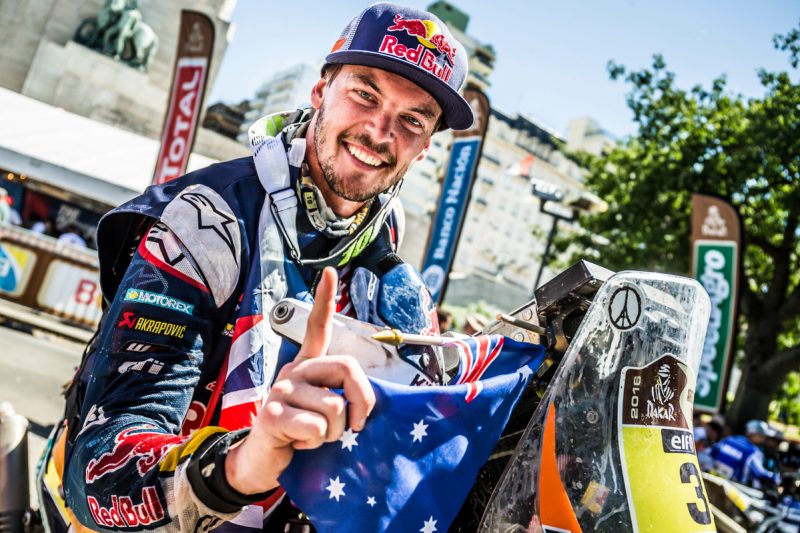
Toby Price (AUS) KTM 450 RALLY Dakar 2016
The Rally’s Sporting Director Marc Coma promised that the 2017 edition would present the riders with some extreme challenges. There were seven special stages of over 400 kilometers and one even longer than 500 kilometers. The rules regarding navigation were also changed, the aim being to ensure that the rally would remain exciting right up to the last special stage. During the fourth stage, Toby Price unfortunately crashed and broke his femur. From that point on, Matthias Walkner and Sam Sunderland were at the front of the field flying the flag for Red Bull KTM. These two riders plus the Spanish KTM rider Gerard Farres made it three KTMs amongst the top five before the rest day in La Paz. By stage 10 Sunderland gained a comfortable lead which now needed to be maintained till crossing the finish line. With a gap of 33 minutes the second placed Matthias Walkner started off into the last stage from Rio Cuarto to Buenos Aires. Still some excitement was caused by Farres Guell who had an advantage of less than a minute on the fourth placed rider and still had the podium within reach. The last special stage probably became the longest 64 kms in Sunderland´s life, but finally “SuperSam” Sunderland gained the 16th consecutive win for KTM at the Dakar Rally. The three-way podium for KTM was completed by Matthias Walkner and Gerard Farres Guell taking the places 2 and 3 – again an orange success!
Photos/Video: KTM


